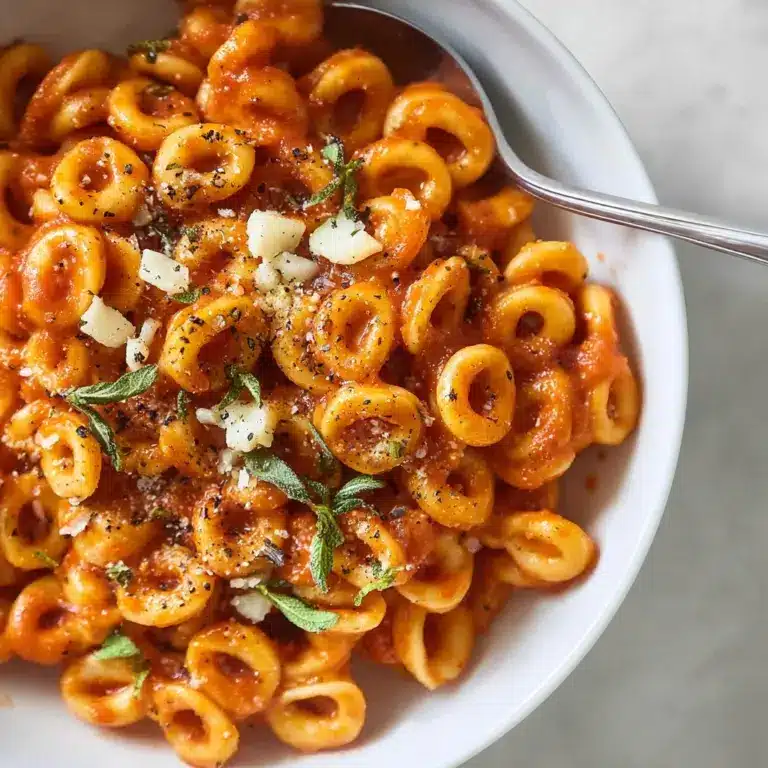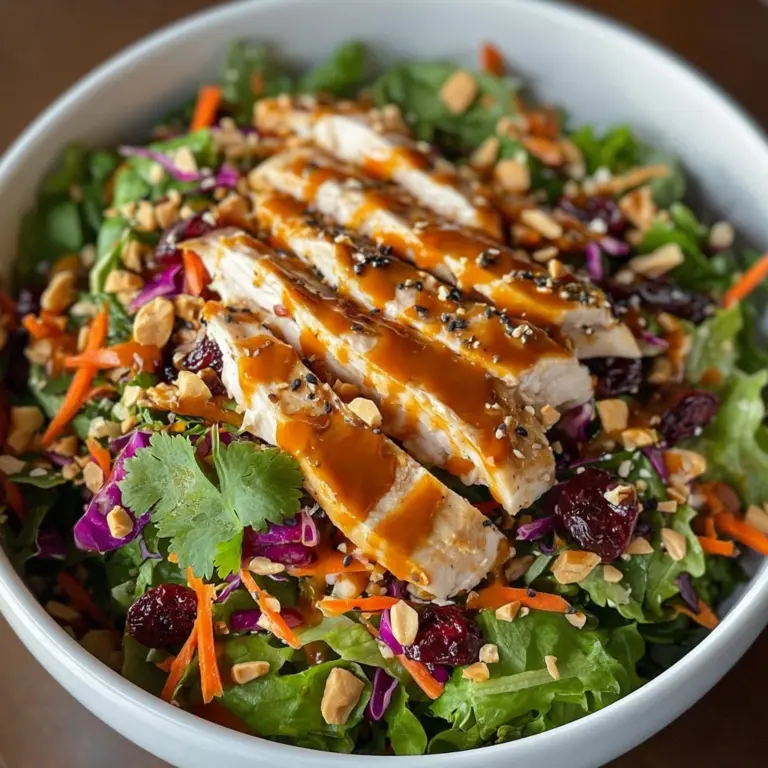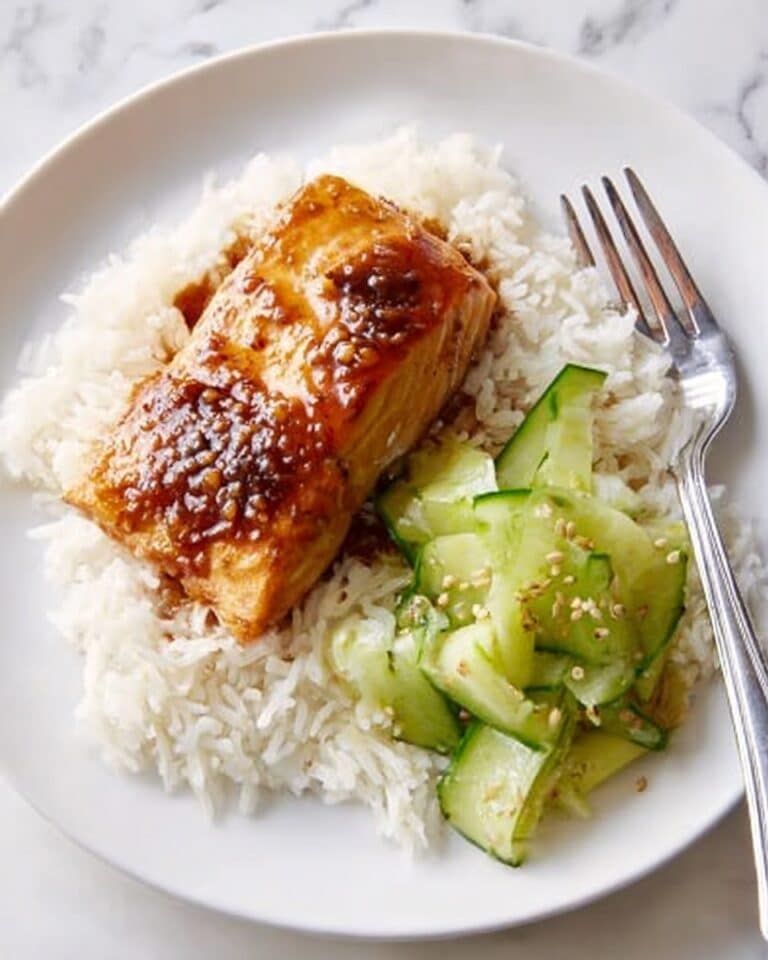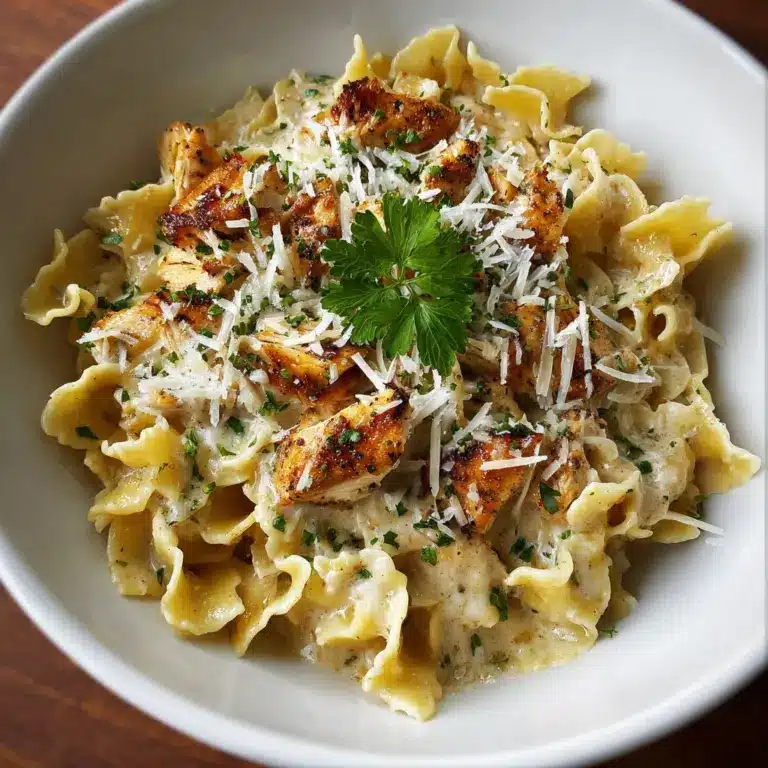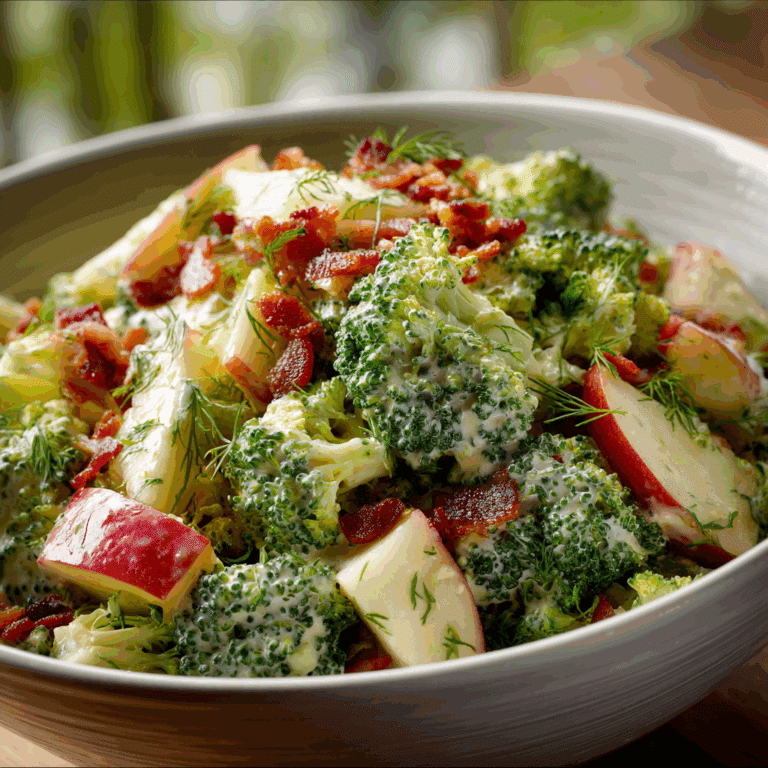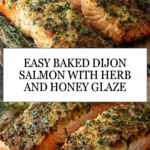Baked Salmon Fillets Dijon Recipe
If you’re craving a dish that’s both elegant and incredibly simple to whip up, look no further than these irresistibly flavorful Baked Salmon Fillets Dijon. This recipe brings together the rich, buttery texture of salmon with the tangy kick of Dijon mustard, enhanced by fragrant herbs and a touch of honey’s natural sweetness. Every bite offers a perfect balance of zest and warmth that feels like a cozy hug on a plate. Whether you’re cooking for yourself or impressing guests, Baked Salmon Fillets Dijon is a go-to recipe that never fails to delight.
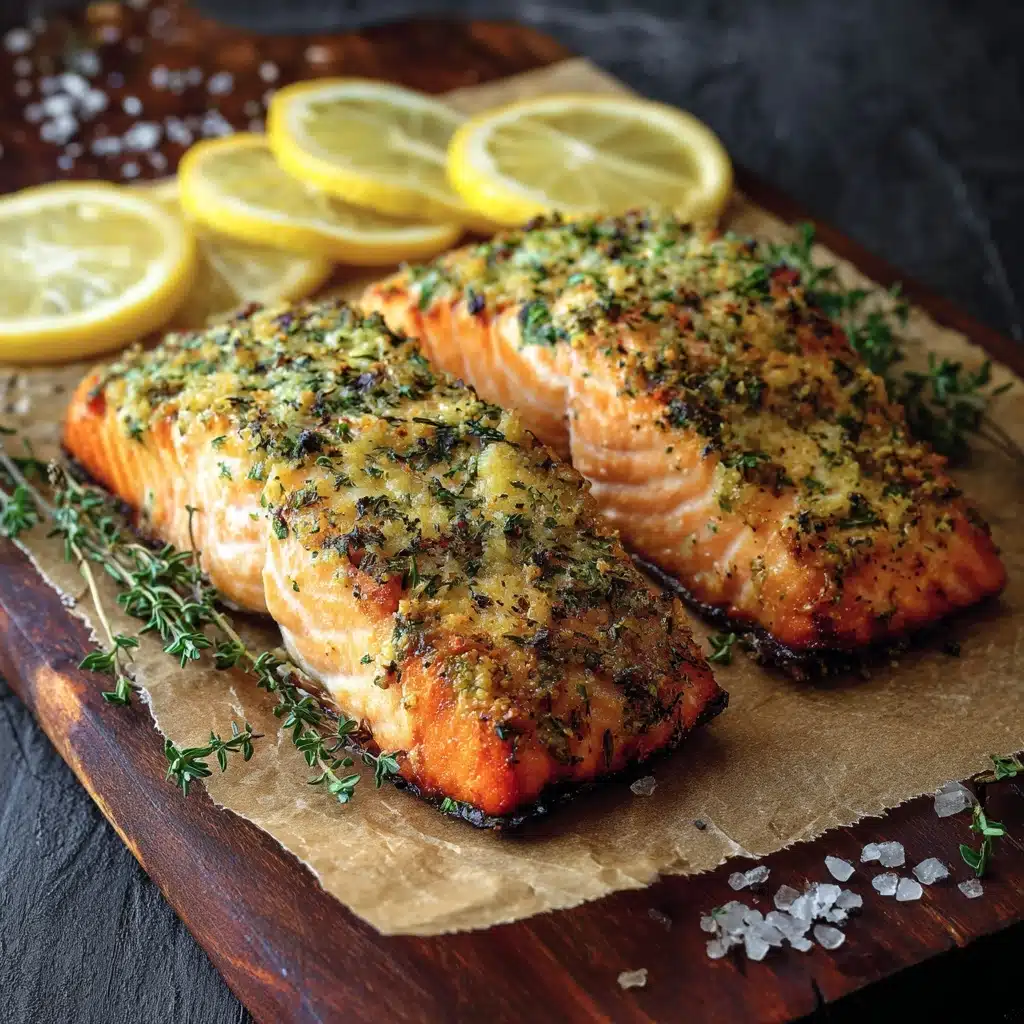
Ingredients You’ll Need
The beauty of this recipe lies in its straightforward ingredients, each chosen for their role in building layers of flavor and complementing the salmon’s natural richness. Fresh herbs, bright lemon, and a smooth olive oil base work in harmony to create a glaze that is both delicious and visually appealing.
- Salmon fillets: Choose fresh, firm fillets about 6 ounces each for perfect portions and optimal texture.
- Dijon mustard: This provides the signature tangy flavor that elevates the dish without overpowering the salmon.
- Olive oil: Adds richness and helps meld the flavors together while keeping the fish moist during baking.
- Honey: Just a touch to balance the mustard’s sharpness with gentle sweetness.
- Lemon juice: Freshly squeezed to brighten the overall taste and add a crisp finish.
- Garlic: Minced finely for a subtle pungency that works beautifully with the herbs.
- Dried thyme and rosemary: These herbs impart an earthy, aromatic quality that complements the salmon perfectly.
- Salt and pepper: Essential seasonings to enhance every other ingredient.
- Lemon slices (optional): For a vibrant garnish that adds a pop of color and extra citrus scent.
- Fresh parsley (optional): Adds a fresh, herbal brightness that finishes the dish beautifully.
How to Make Baked Salmon Fillets Dijon
Step 1: Preheat and Prepare Your Oven
Start by preheating your oven to a steady 375°F (190°C). This temperature ensures the salmon cooks evenly, preserving its tender texture and allowing the mustard glaze to caramelize just right.
Step 2: Whisk Together the Dijon Mixture
In a medium bowl, combine the Dijon mustard, olive oil, honey, lemon juice, minced garlic, dried thyme, dried rosemary, salt, and pepper. Whisk these ingredients until the mixture is smooth and glossy. This step is where the magic begins, creating a harmonious glaze that’s packed with flavor.
Step 3: Prepare the Salmon for Baking
Place your salmon fillets skin side down on a baking dish. Using a basting brush or spoon, generously coat each fillet with the Dijon mixture. Don’t be shy—this generous layer is what makes the dish shine.
Step 4: Optional Foil Cover for Moisture
If you prefer an extra moist salmon, cover the baking dish loosely with aluminum foil. This traps steam during the first half of baking, keeping the fish succulent without compromising that beautiful glaze.
Step 5: Bake Until Perfectly Flaked
Pop the dish into the oven and bake for approximately 15 minutes. You’ll know it’s done when the salmon flakes easily with a fork and has an opaque, gently pink center. The glaze will form a slightly caramelized crust that’s simply irresistible.
Step 6: Rest and Garnish
Remove the salmon from the oven and allow it to rest for a few minutes. This lets the juices redistribute, resulting in a more flavorful bite. Finally, garnish with lemon slices and fresh parsley if you like, adding brightness and a lovely visual finish.
How to Serve Baked Salmon Fillets Dijon
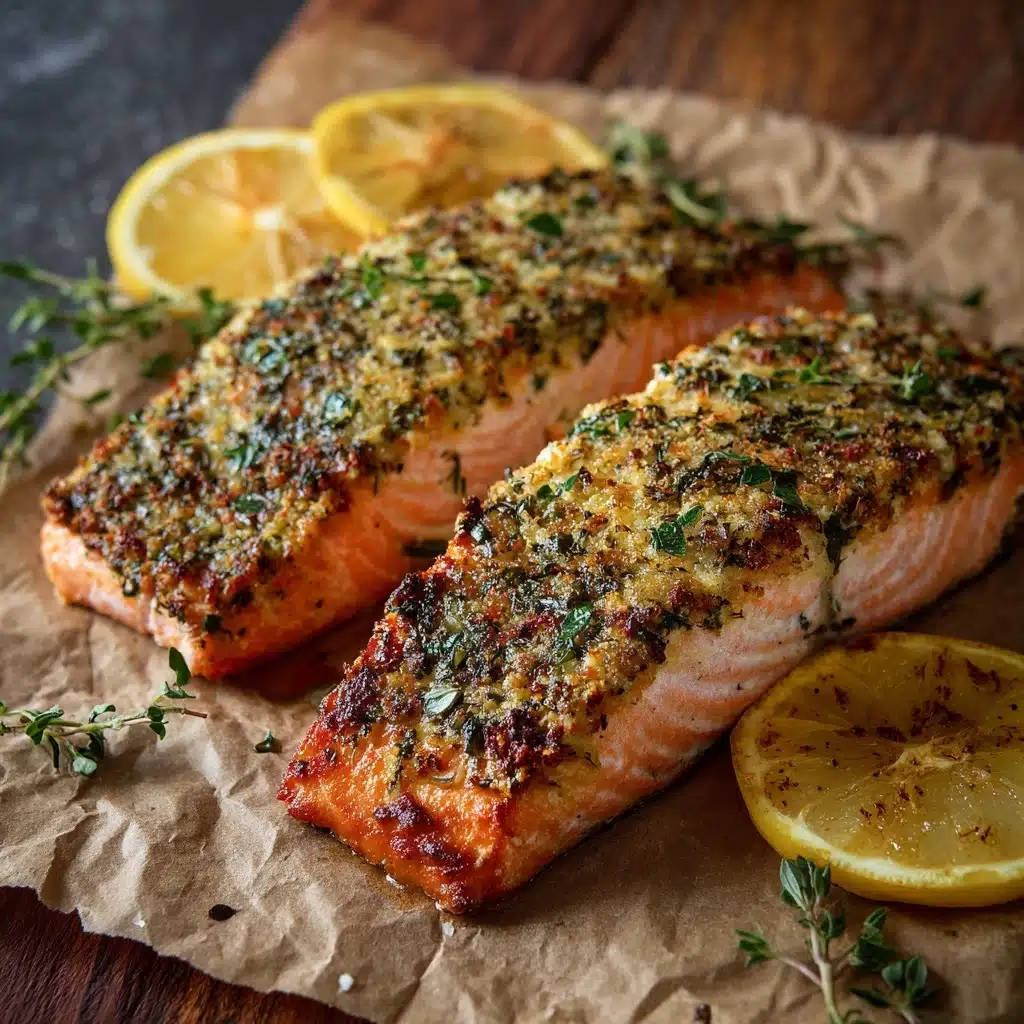
Garnishes
Fresh garnishes like curly parsley or thin lemon slices do more than decorate—they add a fresh pop that cuts through the rich Dijon glaze and highlights the salmon’s natural flavor.
Side Dishes
Pair these fillets with simple, fresh sides like roasted asparagus, garlic mashed potatoes, or a crisp green salad. Each complements the baked salmon without competing with its bold, herbaceous character.
Creative Ways to Present
Try serving the fillets over a bed of quinoa or wild rice, drizzled lightly with extra lemon juice. For a special touch, plate each portion with a small spoonful of crème fraîche or a dollop of herb-infused yogurt to add a creamy contrast to the tangy Dijon glaze.
Make Ahead and Storage
Storing Leftovers
Once cooled, place leftover salmon fillets in an airtight container and refrigerate for up to two days. The flavors meld well overnight, making for a delicious next-day meal.
Freezing
You can freeze cooked salmon by wrapping it tightly in plastic wrap and aluminum foil, then storing it in a freezer bag for up to one month. For best taste, thaw overnight in the fridge before reheating.
Reheating
Reheat gently in a low oven set to 275°F (135°C) for about 10 minutes, or until warmed through. Avoid the microwave when possible, as it can dry out the salmon and toughen the glaze.
FAQs
Can I use fresh herbs instead of dried thyme and rosemary?
Absolutely! Fresh herbs will give a brighter, more vibrant flavor. Use about three times the amount of fresh in place of dried, and add them towards the end of mixing to keep their essence intact.
Is it necessary to cover the salmon with foil while baking?
Covering with foil is optional but helpful if you want extra moist, tender salmon. It traps steam for the first half of baking, but removing it halfway allows the glaze to brown beautifully.
Can I make this recipe with other types of fish?
Yes, firm fish like cod or halibut will work well. Adjust baking time slightly depending on thickness, as these fish cook differently than salmon.
How do I prevent the salmon from sticking to the baking dish?
Lightly grease the baking dish with olive oil or line it with parchment paper before placing the salmon. This simple trick makes cleanup easier and helps keep the fillets intact when serving.
What wine pairs best with Baked Salmon Fillets Dijon?
A crisp white wine like Sauvignon Blanc or a light Pinot Noir perfectly complements the tangy mustard and herbaceous notes without overpowering the salmon.
Final Thoughts
There’s something truly special about Baked Salmon Fillets Dijon that makes it a standout in your dinner rotation—effortless to prepare yet bursting with incredible flavor. I hope you’ll give this recipe a try soon, and discover how wonderfully simple ingredients can create a meal that feels both comforting and elegant. It’s a personal favorite that never disappoints, and I’m sure it’ll become yours too!
Print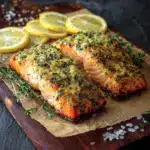
Baked Salmon Fillets Dijon Recipe
- Total Time: 25 minutes
- Yield: 4 servings 1x
- Diet: Low Fat
Description
This baked salmon fillets recipe features tender, flaky salmon coated with a flavorful Dijon mustard glaze, enhanced with honey, lemon, garlic, and herbs. It’s an easy and healthy dish perfect for a quick weeknight dinner or a special occasion, combining bright citrus notes with aromatic thyme and rosemary.
Ingredients
Salmon Fillets
- 4 fillets salmon (About 6 ounces each)
Dijon Glaze
- 2 tablespoons Dijon mustard
- 2 tablespoons olive oil
- 1 tablespoon honey
- 1 tablespoon lemon juice
- 2 cloves garlic, minced
- 1 teaspoon dried thyme
- 1 teaspoon dried rosemary
- to taste salt
- to taste pepper
Garnish (Optional)
- lemon slices
- fresh parsley
Instructions
- Preheat Oven: Preheat your oven to 375°F (190°C) to ensure it is hot enough to bake the salmon evenly.
- Prepare Glaze: In a mixing bowl, whisk together Dijon mustard, olive oil, honey, lemon juice, minced garlic, dried thyme, dried rosemary, salt, and pepper until the mixture is smooth and well combined.
- Arrange Salmon: Place the salmon fillets skin side down in a baking dish. Brush the Dijon glaze generously over the top surface of each fillet to coat them thoroughly.
- Optional Covering: For extra moist salmon, optionally cover the baking dish with aluminum foil during the first half of baking. This helps trap steam and prevents dryness.
- Bake Salmon: Bake the salmon in the preheated oven for about 15 minutes, or until the fish easily flakes with a fork and is cooked through but still juicy inside.
- Rest and Garnish: Remove the dish from the oven and allow the salmon to rest for a few minutes. Garnish with lemon slices and fresh parsley if desired before serving.
Notes
- Ensure salmon fillets are of similar size for even cooking.
- You can substitute fresh thyme and rosemary if preferred, using about 1 tablespoon of each.
- Adjust honey quantity for sweetness to taste.
- Serving with steamed vegetables or rice complements this dish well.
- Leftovers can be refrigerated and consumed within 2 days.
- Prep Time: 10 minutes
- Cook Time: 15 minutes
- Category: Main Course
- Method: Baking
- Cuisine: American
Nutrition
- Serving Size: 1 fillet (about 6 oz)
- Calories: 320
- Sugar: 4g
- Sodium: 420mg
- Fat: 18g
- Saturated Fat: 3g
- Unsaturated Fat: 13g
- Trans Fat: 0g
- Carbohydrates: 5g
- Fiber: 0.5g
- Protein: 34g
- Cholesterol: 85mg
Keywords: baked salmon, Dijon mustard salmon, healthy salmon recipe, honey lemon salmon, easy salmon dinner

